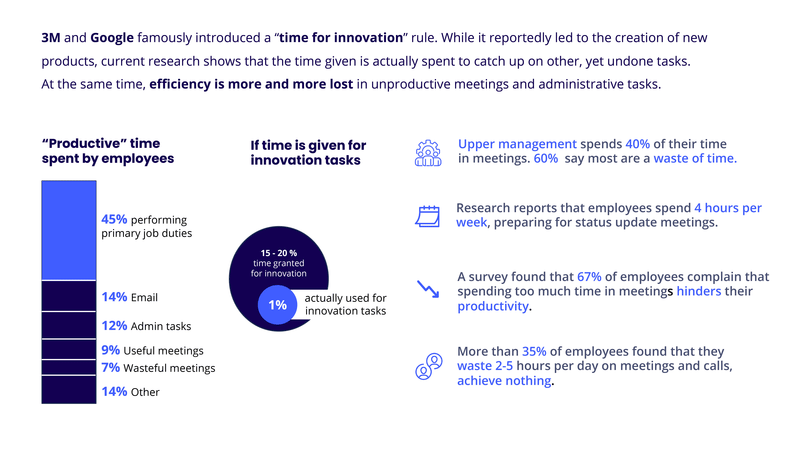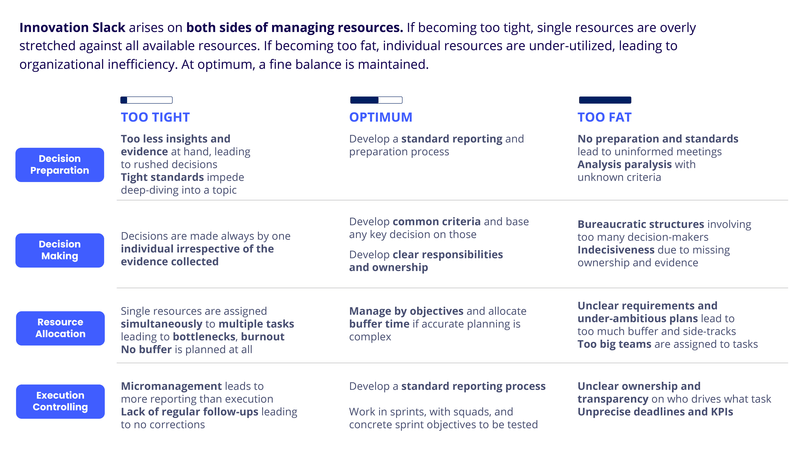Organizational innovation slack, the surplus of resources that exceeds the minimum necessary, is a double-edged sword. While some say slack fuels creativity, others claim excessive slack leads to waterfall thinking, too generous investments, and being too late to capture significant innovation rents. In this article, we show that finding the right innovation weight is beneficial. We’ll take you through strategies to drive innovation efficiency by reducing overhead, ambiguous decision processes, and too-tight or too-fat resource allocation.
The general consensus is organizations must be agile and fast to win the innovation race. Being first to market promises some significant innovation rents: the ability to set standards, collect revenue earlier, and lock in customers early. Yet, not all companies innovate at top speed. Some leave time for pit stops in between.
A key reason for not moving at the fastest speed possible is the development of organizational innovation slack. Innovation slack appears when resources are managed too tightly or too loose. Both sides lead to inefficiencies and delays.
If individual resources are managed too tightly, they are overly stretched against all available resources. This is a bad type of slack since the work done by single individuals can be better split across different people, reducing individual effort and increasing collective efficiency as well as speed. Giving individuals and firms extra resources will help accommodate for irregularities, surprises, and reflections.
While giving extra resources, the organizational innovation slack will increase weight and can create other inefficiencies. If the slack becomes too fat and involves too many individuals, the consequence will be a lack of ownership and cutting of other individual tasks. Put differently, too much innovation slack will under-utilize individual resources, create organizational inefficiency, and slow down processes.
Does granting more time lead to better innovation outcomes?
The conclusion of managing resources too tightly or too baggy is always to find the right weight.
The effect of giving slack to innovation programs can be prodigious: 3M Co. attributes the development of the Post-it Note to its 1948 decision to allow employees to devote 15% of their paid time to side projects; and Google says its “20% rule,” which upped the ante on the slack time devoted to innovation, yielded Gmail, AdSense, and Google Earth. However, few companies have persevered with time allocated to innovation and other slack-based programs for as long as 3M. Even Google has reportedly waxed and waned in its commitment to its 20% rule.
In contrast to these success stories of giving employees slack time to innovate, Atlassian carefully tested the effect of such a policy within their 20%-Time Experiment. Surprisingly, as little as 1.1 percent of the time was spent. The remaining time was instead used to catch up on the regular job duties. It was also reported that - until the publication of the statistics - one-third of the projects started made it into products - even with the little extra time devoted to innovation.
This leaves us with the question of whether it is necessary to grant extra time to innovate or not. If time is granted to innovate but not used for that purpose, it’s used inefficiently. In such a situation, the surplus of resources granted is wasted - at least from an innovation perspective. However, it is also widely acknowledged that it takes time to contemplate ideas, understand market desires, and find the best solutions. In such situations, extra resources and time can help to cut a diamond.

Looking at some statistics on how employees make use of their working time, the dimensions of innovation slack become apparent. Innovation slack typically arises in:
- the preparation of decisions,
- decision-making itself,
- resource allocation/utilization, and
- execution control
People in upper management report that they spend considerable amounts of time in meetings. Yet, the majority of time spent is wasted. As the job of upper management is to make decisions, it can be concluded that most of these meetings are not well prepared, and the time until a decision is made is delayed. Employees report the same as they waste 2 to 5 hours per day on meetings and calls, hindering productivity. This speaks to inefficient execution and resource allocation.
The statistics also shed some light on providing extra time to innovate. Employees spend half their time on primary job duties and the other half on administrative tasks. If they should now spend up to 20 percent of their time to innovate, it is clear that they need to cut down on other tasks. While there might still be some potential to reduce wasteful meetings and admin tasks, it will be difficult to reduce those in proportion to the time given to innovate. The consequence is that they need to cut productive time or work extra hours which might lead to a negative perception of innovation efforts at the organization. It thus might be best if working on innovative topics becomes part of someone’s primary job duties.
The innovation slack spectrum: Finding the ideal weight
Companies can create a more dynamic, agile, and efficient innovation environment by proactively addressing innovation slack - being too tight or fat. This not only enhances their ability to respond to market changes and seize new opportunities but also drives sustainable growth, competitive advantage, and operational efficiency. It’s about finding the right balance when it comes to preparing and making decisions, allocating resources, and controlling the execution.
Check your organization’s innovation slack level by comparing our observations of what might be too tight and what might be too fat.

As shown above, decision-makers feel they waste much of their time in insufficient meetings. A central reason for that is improper preparation. If too much room is given, it might result in no preparation at all. Missing standards (e.g., agenda, role distribution, preparation documents) will lead to uninformed meetings. Most of the time, the preparation also includes collecting, analyzing, and interpreting insights. With too broad a focus, including no standard formats to present results, analysis paralysis is often the result. With analysis paralysis, the group is unable to move forward with a decision due to overthinking or overanalyzing the data and options. In essence, it’s when the fear of potential errors, the quest for perfect solutions, or the prospect of predicting every possible outcome impedes progress and prevents timely decision-making.
On the other side of the decision preparation spectrum, we see too little evidence and insights since information is not analyzed thoroughly. This comes with the risk of overlooking critical information. As a result, decisions will be rushed. That is why it is important to build appropriate processes that counteract the slack that arises in decision preparation when managed too tightly or too baggy.
The effects of insufficient decision preparation most often also spill over into the second dimension where innovation slack arises: decision-making. Decision-making must be agile yet thorough. On the too-tight side, slack arises if only single individuals make all the decisions. This improperly uses the collective intelligence of the organization. On the too-fat side, we see the other extreme, where too many individuals are included in making decisions, leading to indecision and lengthy debates. To counteract this, it is important to build a single home for collaborating and informing decisions. It will be easier to follow common rules and decision criteria within this single home. It will also be easier to track ownership and enforce individual responsibilities.
Making decisions commonly involves the allocation of resources. The goal in avoiding unnecessary innovation slack is to not waste valuable resources on unviable projects. It is also important to not assign valuable resources simultaneously to multiple projects since it risks creating bottlenecks and burnout. This can be a result of not providing any buffer and squeezing resources to the max. On the other side, if plans are not ambitious enough or responsibilities are unclear, it might result in too much buffer and sidetracking. A good way to find the right balance is the principle of managing with objectives and providing a buffer when accurate planning is complex.
While employees are busy working on innovation tasks, management wishes to keep an eye on task completion and ensure it stays within time, budget, and scope. This can lead to micromanagement and more reporting than execution. If not handled properly, it can also lead to delays and surprises if not supervised at all. Within an agile framework, working in sprints, with squads and smaller sprint objectives has created more efficient operations. This framework turned out to also be a good way to counteract unclear ownership and missing deadlines.
These balances form the backbone of an agile, innovative, and successful organization. The aforementioned emphasizes the perpetual challenge of fine-tuning these dimensions to align with changing goals and market conditions, highlighting the need to manage innovation slack properly and not become too fat or too tight.
Take our innovation maturity assessment to check the readiness of your organization to innovate.




